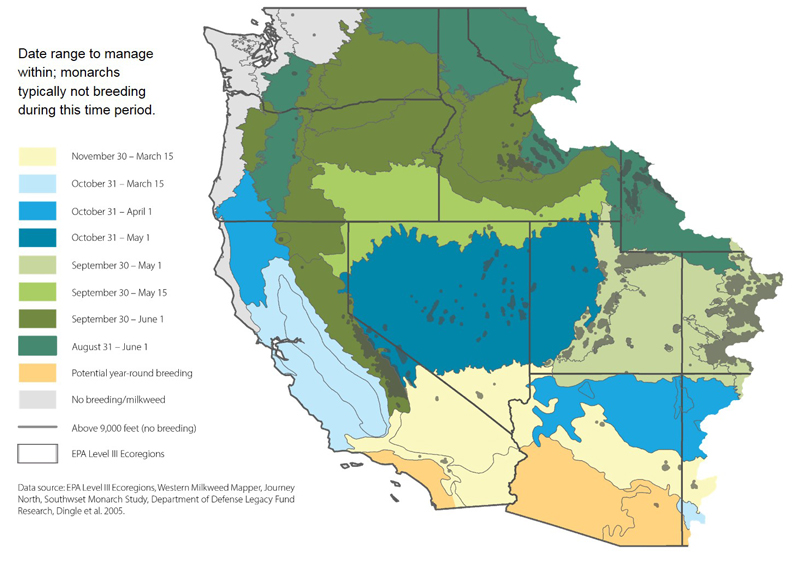A new guide to protecting the monarch butterfly from the Pacific to the Rockies presents a holistic approach to monarch conservation.
Monarch butterflies in western North America are in trouble. What was once a huge number of monarchs that converged on overwintering sites in coastal California has dwindled year after year. The number of butterflies has fallen by more than 95% since the 1980s, with declines also observed in breeding populations during the spring and summer. With monarch numbers dipping so low, more and more people are wondering what they can do to help recover the butterfly and milkweed—its host plant—across the West.
To guide conservation efforts, the Xerces Society for Invertebrate Conservation has published Managing for Monarchs in the West: Best Management Practices for Conserving the Monarch Butterfly and its Habitat. This document combines the best-available science with land-manager knowledge to provide recommendations for managing monarch breeding and migratory habitat.
Managing for Monarchs in the West provides a summary of the known effects of frequently used land-management practices—grazing, mowing, prescribed fire, and pesticides—on monarchs and their breeding and migratory habitat. This is followed by best management practices (BMPs) for integrating monarch conservation in management decisions. Guidance on timing management activities gives land managers confidence in knowing when they can mow, burn, or graze land without disrupting breeding monarchs. Management of invasive, nonnative, and noxious plants; recreation; and climate change impacts are also addressed.

The most important part of monarch conservation in the West is to identify, protect, and appropriately manage existing high-quality monarch habitat. This habitat consists of native milkweeds to provide both food for caterpillars and nectar for adults, as well as other flowers—preferably native—that also provide nectar for adults. These areas are also safe from pesticides and safeguard butterflies against high levels of pathogens. Additional factors such as roosting habitat and shade may also be important, but less is known about these features.
The new guidance presents a holistic approach to monarch conservation—moving beyond just planting milkweed. It provides information on planting milkweed in places where the plant is ecologically and historically appropriate and provides details on native species’ ranges, habitat associations, and establishment techniques.
The BMPs cover where and when to incorporate monarch habitat in restoration projects—identifying areas of high potential by using habitat-suitability modeling and an extensive trove of thousands of milkweed and monarch records. In some areas—such as the Central Valley of California, where milkweed has likely been lost—targeted enhancement and restoration using milkweed may be appropriate. Species lists for native milkweed and nectar plants, as well as information on sourcing and establishing native plants, provide managers with relevant technical guidance. The guidance in this document is intended for use by public land managers, as well as others who manage natural areas and rangelands in the western United States and are interested in contributing to the recovery of the monarch butterfly.

Community science has played a major role in our understanding of the status, movement, mortality, and distribution of monarch populations, and it is covered in a section on monitoring monarch populations (including major tagging and tracking programs). The document also serves as a valuable reference, outlining existing western monarch–related guides and information hubs with dozens of links to additional resources for those who want to know more about a specific topic.
To help reverse the western monarchs’ population trend, we need to improve protection and management of the butterfly’s habitat across its range—especially on public lands. These BMPs provide actionable, practical guidance that empowers western land managers to be part of the solution.
Further Reading
Learn more about our western monarch conservation work.
Learn more about our North America-wide monarch conservation efforts.




